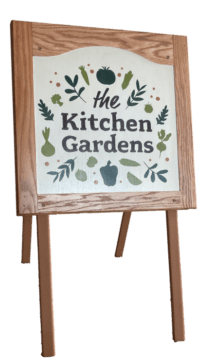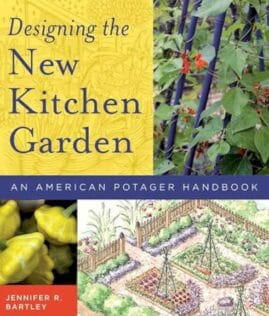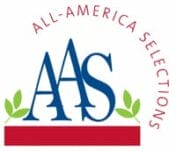Annual Gardens
Annuals Theme 2024:
"the Kitchen Gardens"
The Annual Beds Are Cooking Up Something New!

The 16 small gardens next to the DABG Visitor Center are taking a "fresh” approach this season by mixing vegetables and herbs with traditional annual flowers.
Dubbed “The Kitchen Gardens,” these flowerbeds will display a variety of plants, both edible and decorative, while also promoting sustainable gardening practices and healthy eating. Already the new plan has required less energy for heating and cooling the greenhouses, less potting soil and water, and fewer volunteer hours for planting and irrigating.
Summer visitors will still see the usual splash of colorful annuals in the drive-by flowerbed next to the road and in the two large gardens alongside McKay Plaza, including blue salvia, white pentas, carmine wave petunias, and apricot vinca. Annual flowers will also border the kitchen gardens. But most of the vegetables and herbs within those beds have been planted directly in the ground, enabling the plants to develop stronger roots and more normal growth patterns than when sown early in a greenhouse. Slower-growing plants (peppers, tomatoes, and cabbages) were purchased as seedlings from local nurseries.
Traditionally, a “kitchen garden” is located just outside the kitchen door, making it easy for the cook to dash outside and grab a fresh zucchini or sprig of basil. Should we be lucky enough to produce any bumper crops this year, we will donate our excess vegetables so that they can be eaten!
In addition to vegetables, edible flowers to look for in the kitchen gardens include lemon marigolds, nasturtiums, and calendula. Interesting color will be added by purple cauliflower, rainbow Swiss chard, and black pole beans. Blooms that may be unfamiliar to some visitors are rose-red buckwheat, okra blossoms, blue butterfly pea vine, and a globe artichoke. A collection of herbs in one of the gardens includes parsley, sage, rosemary, and thyme.
In addition to their environmental benefits, the kitchen gardens will demonstrate companion planting, whereby certain crops help each other when grown together. For example, the “Three Sisters Garden” illustrates the Native American custom of planting sweet corn, pole beans, and butternut squash in a specific pattern. The cornstalks give the beans a structure to climb so that they are out of the way of the spreading squash plants; the beans add nitrogen to fertilize the soil while also stabilizing the corn; and the large squash leaves shade the ground and help keep the soil moist.
Flowers and vegetables can be “companions” as well. The zinnias bordering many of the beds will attract bees and butterflies, while nasturtiums will hopefully discourage certain undesirable insects from munching on our vegetables.
We are also experimenting with an alternative gardening method: a “Straw Bale Garden.” Two bales of straw in the center of one of the flowerbeds were treated with water and fertilizer before being planted with vegetable seedlings. As the straw continuously decomposes during the season, it provides nutrients to the plants. Because the bales are raised off the ground, they are easily accessible to the gardener and limit weeds, soil-borne diseases, and in-ground pests.
The concept of kitchen gardening is not new—it goes back to medieval times in the Middle East and Europe. The French term for a kitchen garden is potager (po-tah-zhay); in Scotland, it would be called a kailyard. Early illustrations show geometrical, raised potager gardens on the grounds of monasteries and chateaus that are strikingly similar to the arrangement of square flowerbeds designed by the DABG founders in the early 1980s. In addition, our small beds will allow easy reach when the vegetables are ready to be picked.
Sources:



ANNUALS
For a show of pure color, few plants can measure up to the contribution of annuals in a garden. Annual plants:
- grow from seed,
- flower,
- produce new seeds, and
- die during a single growing season.
Greenhouse Activities. Volunteers can be found in January in the greenhouse — packets of seed in hand! — ready to start the germination process. During the early months of each calendar year, thousands of annuals gradually fill two greenhouses as volunteers upgrade seedlings into pots ready to be planted in mid-May.
Ideal for providing changing color from year to year in gardens, the Annual Gardens in our Botanical Gardens are easily spotted. As you approach the Visitor Center, you'll come upon a vast area of large and smaller beds bursting with color: the annual beds! As you make your way along the pathways in this area, you may notice that the majority of these beds follow a theme. Each year a different theme is designed and carried out by members of the Green Team. Garden volunteers and Arboretum guests sometimes get into the spirit by suggesting themes for upcoming years.
Our AAS Display Garden. Every year the Dubuque Arboretum & Botanical Gardens looks forward to receiving sample flower seeds or plugs that have been named All-America Selections based on their garden performance in tests conducted throughout the United States.
During 2023 our AAS Garden will display the following winners* ...
2023 Winners:
- Blue-by-You Salvia, perennial winner
- Doubleshot Orange Bicolor Snapdragon, ornamental seed winner
- Coral Candy Premium Sun Coleus, ornamental seed winner
2022 Winners:
- Bees Knees petunias, 2022 Gold Medal ornamental winner
- Concert Bell Sunflower, 2022 winner (planted in a shrub berm)
2020 Winner:
- Amarillo Gold Rudbeckia, flower winner
*Previous AAS winners are also included in other gardens and marked as such.

WITH APPRECIATION Creation, care, and maintenance of the Annual Gardens: the Green Team.


